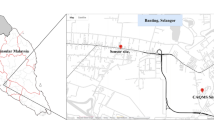Abstract
Users of automatic air pollution monitors are largely unaware of how certain parameters, like temperature, can affect readings. The present work examines the influence of temperature changes on chemiluminescence NOx measurements made with a Thermo Scientific 42i analyzer, a model widely used in air monitoring networks and air pollution studies. These changes are grouped into two categories according to European Standard EN 14211: (1) changes in the air surrounding the analyzers and (2) changes in the sampled air. First, the sensitivity tests described in Standard EN 14211 were performed to determine whether the analyzer performance was adapted to the requirements of the standard. The analyzer met the performance criteria of both tests; however, some differences were detected in readings with temperature changes even though the temperature compensator was on. Sample temperature changes were studied more deeply as they were the most critical (they cannot be controlled and differences of several tens of degrees can be present in a single day). Significant differences in readings were obtained when changing sample temperature; however, maximum deviations were around 3% for temperature ranges of 15°C. If other possible uncertainty contributions are controlled and temperature variations with respect to the calibration temperature are not higher than 15°C, the effect of temperature changes could be acceptable and no data correction should have to be applied.




Similar content being viewed by others
References
Cal/EPA (2007) Review of the California Ambient Air Quality Standard for nitrogen dioxide. Technical Support Document. http://www.arb.ca.gov/aaqm/qmosqual/qamanual/vol4/measurement_of_nox.pdf.
CEN (Comité Européen de Normalisation) (2005) Air quality—standard method for the measurement of the concentration of nitrogen dioxide and nitrogen monoxide by chemiluminescence. EN 14211.
EC Directive. (2008). Council Directive 2008/50/EC on ambient air quality and cleaner air for Europe. Official Journal of the European Communities, L151, 1–44.
Doval Miñarro, M., González Ferradás, E., Romero Trigueros, C., & Barberá Rico, J. (2011a). Do pressure changes have an influence on ambient air chemiluminescence NOx measurements? Atmospheric Environment, 45, 5366–5375.
Doval Miñarro, M., Gonzalez Ferradás, E., Barberá Rico, J., Díaz Alonso, F., Marzal Martínez, F. J., & Romero Trigueros, C. (2011b). Study of the uncertainty in NO2 chemiluminescence measurements due to the NO-O3 reaction in sampling lines. Environmental Science and Pollution Research, 18, 436–445.
Dunlea, E. J., Herndon, S. C., Nelson, D. D., Volkamer, R. M., Lamb, B. K., Allwine, E. J., et al. (2006). Technical note: evaluation of standard ultraviolet absorption ozone monitors in a polluted urban environment. Atmospheric Chemistry and Physics, 6, 3163–3180.
Fontijn, A., Sabadell, E. J., & Ronco, R. J. (1970). Homogeneous chemiluminescent measurement of nitric oxide with ozone. Analytical Chemistry, 42, 575–579.
Fried, A., Henry, B., Parrish, D. D., Carpenter, J. R., & Buhr, M. P. (1991). Intercomparison of tunable diode-laser and gas filter correlation-measurements of ambient carbon monoxide. Atmospheric Environment Part A—General Topics, 25, 2277–2284.
Glover, J. H. (1975). Chemiluminescence in gas analysis and flame emission spectrometry. Analyst, 100, 449–464.
Holloway, J. S., Jakoubek, R. O., Parrish, D. D., Gerbig, C., Volz-Thomas, A., Schmitgen, S., et al. (2000). Airborne intercomparison of vacuum ultraviolet fluorescence and tunable diode laser absorption measurements of tropospheric carbon monoxide. Journal of Geophysical Research—Atmospheres, 105, 21251–24261.
Leston, A. R., Ollison, W. M., Spicer, C. W., & Satola, J. (2005). Potential interference bias in ozone standard compliance monitoring. Journal of the Air & Waste Management Association, 55, 1464–1472.
Luke, W. T. (1997). Evaluation of a commercial pulsed fluorescence detector for the measurement of low-level SO2 concentrations during the gas-phase sulphur intercomparison experiment. Journal of Geophysical Research—Atmospheres, 102, 16255–16265.
Spicer, C. W., Joseph, D. W., & Ollison, W. M. (2010). A re-examination of ambient air ozone monitor interferences. Journal of the Air & Waste Management Association, 60, 1353–1364.
Williams, E. J., Fehsenfeld, F. C., Jobson, B. T., Kuster, W. C., Goldan, P. D., Stutz, J., et al. (2006). Comparison of ultraviolet absorbance, chemiluminescence and DOAS instruments for ambient ozone monitoring. Environmental Science & Technology, 40, 5755–5762.
Wilson, K. L., & Birks, J. W. (2006). Mechanism and elimination of a water vapour interference in the measurements of ozone by UV absorbance. Environmental Science & Technology, 40, 6361–6367.
Acknowledgements
We would like to acknowledge the Agencia Regional de Ciencia y Tecnología–Fundación Séneca de Murcia for its support in this study (project 05705/PI/07) and for giving a pre- and post-doctoral grant to M. Doval Miñarro (01210/FPI/03 and 12400/PD/09). We would also like to thank the Consejería de Agricultura y Agua of the Comunidad Autónoma de la Región de Murcia for its financial support and for the facilities to carry out this work.
Author information
Authors and Affiliations
Corresponding author
Rights and permissions
About this article
Cite this article
Miñarro, M.D., Ferradás, E.G. & Martínez, F.J.M. Influence of temperature changes on ambient air NOx chemiluminescence measurements. Environ Monit Assess 184, 5669–5678 (2012). https://doi.org/10.1007/s10661-011-2372-4
Received:
Accepted:
Published:
Issue Date:
DOI: https://doi.org/10.1007/s10661-011-2372-4




